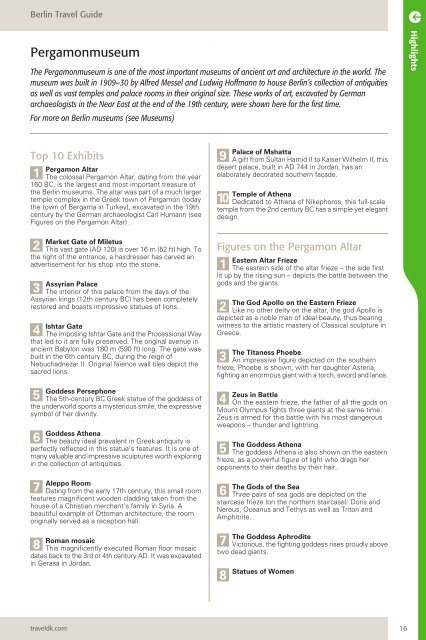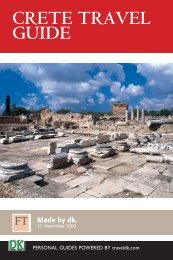You also want an ePaper? Increase the reach of your titles
YUMPU automatically turns print PDFs into web optimized ePapers that Google loves.
Berlin Travel Guide<br />
Pergamonmuseum<br />
The Pergamonmuseum is one of the most important museums of ancient art and architecture in the world. The<br />
museum was built in 1909–30 by Alfred Messel and Ludwig Hoffmann to house Berlin’s collection of antiquities<br />
as well as vast temples and palace rooms in their original size. These works of art, excavated by German<br />
archaeologists in the Near East at the end of the 19th century, were shown here for the first time.<br />
For more on Berlin museums (see Museums)<br />
Top 10 Exhibits<br />
1<br />
Pergamon Altar<br />
The colossal Pergamon Altar, dating from the year<br />
160 BC, is the largest and most important treasure of<br />
the Berlin museums. The altar was part of a much larger<br />
temple complex in the Greek town of Pergamon (today<br />
the town of Bergama in Turkey), excavated in the 19th<br />
century by the German archaeologist Carl Humann (see<br />
Figures on the Pergamon Altar) .<br />
2<br />
Market Gate of Miletus<br />
This vast gate (AD 120) is over 16 m (52 ft) high. To<br />
the right of the entrance, a hairdresser has carved an<br />
advertisement for his shop into the stone.<br />
3<br />
Assyrian Palace<br />
The interior of this palace from the days of the<br />
Assyrian kings (12th century BC) has been completely<br />
restored and boasts impressive statues of lions.<br />
4<br />
Ishtar Gate<br />
The imposing Ishtar Gate and the Processional Way<br />
that led to it are fully preserved. The original avenue in<br />
ancient Babylon was 180 m (590 ft) long. The gate was<br />
built in the 6th century BC, during the reign of<br />
Nebuchadnezar II. Original faïence wall tiles depict the<br />
sacred lions.<br />
5<br />
Goddess Persephone<br />
The 5th-century BC Greek statue of the goddess of<br />
the underworld sports a mysterious smile, the expressive<br />
symbol of her divinity.<br />
6<br />
Goddess Athena<br />
The beauty ideal prevalent in Greek antiquity is<br />
perfectly reflected in this statue’s features. It is one of<br />
many valuable and impressive sculptures worth exploring<br />
in the collection of antiquities.<br />
7<br />
Aleppo Room<br />
Dating from the early 17th century, this small room<br />
features magnificent wooden cladding taken from the<br />
house of a Christian merchant’s family in Syria. A<br />
beautiful example of Ottoman architecture, the room<br />
originally served as a reception hall.<br />
8<br />
Roman mosaic<br />
This magnificently executed Roman floor mosaic<br />
dates back to the 3rd or 4th century AD. It was excavated<br />
in Gerasa in Jordan.<br />
traveldk.com<br />
9<br />
Palace of Mshatta<br />
A gift from Sultan Hamid II to Kaiser Wilhelm II, this<br />
desert palace, built in AD 744 in Jordan, has an<br />
elaborately decorated southern façade.<br />
10<br />
Temple of Athena<br />
Dedicated to Athena of Nikephoros, this full-scale<br />
temple from the 2nd century BC has a simple yet elegant<br />
design.<br />
Figures on the Pergamon Altar<br />
1<br />
Eastern Altar Frieze<br />
The eastern side of the altar frieze – the side first<br />
lit up by the rising sun – depicts the battle between the<br />
gods and the giants.<br />
2<br />
The God Apollo on the Eastern Frieze<br />
Like no other deity on the altar, the god Apollo is<br />
depicted as a noble man of ideal beauty, thus bearing<br />
witness to the artistic mastery of Classical sculpture in<br />
Greece.<br />
3<br />
The Titaness Phoebe<br />
An impressive figure depicted on the southern<br />
frieze, Phoebe is shown, with her daughter Asteria,<br />
fighting an enormous giant with a torch, sword and lance.<br />
4<br />
Zeus in Battle<br />
On the eastern frieze, the father of all the gods on<br />
Mount Olympus fights three giants at the same time.<br />
Zeus is armed for this battle with his most dangerous<br />
weapons – thunder and lightning.<br />
5<br />
The Goddess Athena<br />
The goddess Athena is also shown on the eastern<br />
frieze, as a powerful figure of light who drags her<br />
opponents to their deaths by their hair.<br />
6<br />
The Gods of the Sea<br />
Three pairs of sea gods are depicted on the<br />
staircase frieze (on the northern staircase): Doris and<br />
Nereus, Oceanus and Tethys as well as Triton and<br />
Amphitrite.<br />
7<br />
The Goddess Aphrodite<br />
Victorious, the fighting goddess rises proudly above<br />
two dead giants.<br />
8<br />
Statues of Women<br />
16<br />
Highlights

















